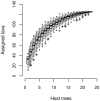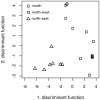Host genotype shapes the foliar fungal microbiome of balsam poplar (Populus balsamifera)
- PMID: 23326555
- PMCID: PMC3543377
- DOI: 10.1371/journal.pone.0053987
Host genotype shapes the foliar fungal microbiome of balsam poplar (Populus balsamifera)
Abstract
Foliar fungal communities of plants are diverse and ubiquitous. In grasses endophytes may increase host fitness; in trees, their ecological roles are poorly understood. We investigated whether the genotype of the host tree influences community structure of foliar fungi. We sampled leaves from genotyped balsam poplars from across the species' range, and applied 454 amplicon sequencing to characterize foliar fungal communities. At the time of the sampling the poplars had been growing in a common garden for two years. We found diverse fungal communities associated with the poplar leaves. Linear discriminant analysis and generalized linear models showed that host genotypes had a structuring effect on the composition of foliar fungal communities. The observed patterns may be explained by a filtering mechanism which allows the trees to selectively recruit fungal strains from the environment. Alternatively, host genotype-specific fungal communities may be present in the tree systemically, and persist in the host even after two clonal reproductions. Both scenarios are consistent with host tree adaptation to specific foliar fungal communities and suggest that there is a functional basis for the strong biotic interaction.
Conflict of interest statement
Figures




Similar articles
-
Relocation, high-latitude warming and host genetic identity shape the foliar fungal microbiome of poplars.Mol Ecol. 2015 Jan;24(1):235-48. doi: 10.1111/mec.13018. Epub 2014 Dec 31. Mol Ecol. 2015. PMID: 25443313
-
Assembly of the Populus Microbiome Is Temporally Dynamic and Determined by Selective and Stochastic Factors.mSphere. 2021 Jun 30;6(3):e0131620. doi: 10.1128/mSphere.01316-20. Epub 2021 Jun 9. mSphere. 2021. PMID: 34106767 Free PMC article.
-
Tree genotype and genetically based growth traits structure twig endophyte communities.Am J Bot. 2014 Mar;101(3):467-78. doi: 10.3732/ajb.1400034. Epub 2014 Mar 14. Am J Bot. 2014. PMID: 24634436
-
Foliar bacterial communities of trembling aspen in a common garden.Can J Microbiol. 2015 Feb;61(2):143-9. doi: 10.1139/cjm-2014-0362. Epub 2014 Nov 13. Can J Microbiol. 2015. PMID: 25602743
-
Relationship between genotype and soil environment during colonization of poplar roots by mycorrhizal and endophytic fungi.Mycorrhiza. 2010 Jun;20(5):315-24. doi: 10.1007/s00572-009-0284-8. Epub 2009 Nov 18. Mycorrhiza. 2010. PMID: 19921284
Cited by
-
Fungal endophytes in aboveground tissues of desert plants: infrequent in culture, but highly diverse and distinctive symbionts.Microb Ecol. 2015 Jul;70(1):61-76. doi: 10.1007/s00248-014-0563-6. Epub 2015 Feb 3. Microb Ecol. 2015. PMID: 25645243 Free PMC article.
-
Genotypic variation in Norway spruce correlates to fungal communities in vegetative buds.Mol Ecol. 2020 Jan;29(1):199-213. doi: 10.1111/mec.15314. Epub 2019 Dec 9. Mol Ecol. 2020. PMID: 31755612 Free PMC article.
-
Host genotype interacts with aerial spore communities and influences the needle mycobiome of Norway spruce.Environ Microbiol. 2022 Aug;24(8):3640-3654. doi: 10.1111/1462-2920.15974. Epub 2022 Mar 22. Environ Microbiol. 2022. PMID: 35315253 Free PMC article.
-
Diversity and Composition of the Leaf Mycobiome of Beech (Fagus sylvatica) Are Affected by Local Habitat Conditions and Leaf Biochemistry.PLoS One. 2016 Apr 14;11(4):e0152878. doi: 10.1371/journal.pone.0152878. eCollection 2016. PLoS One. 2016. PMID: 27078859 Free PMC article.
-
Successive passaging of a plant-associated microbiome reveals robust habitat and host genotype-dependent selection.Proc Natl Acad Sci U S A. 2020 Jan 14;117(2):1148-1159. doi: 10.1073/pnas.1908600116. Epub 2019 Dec 5. Proc Natl Acad Sci U S A. 2020. PMID: 31806755 Free PMC article.
References
-
- Wilson D (1995) Endophyte: the evolution of a term, and clarification of its use and definition. Oikos 73: 274–276 doi:10.2307/3545919 - DOI
-
- Shepherd RW, Wagner GJ (2012) Fungi and leaf surfaces. In: Southworth D, editor. Biocomplexity of plant–fungal interactions. Oxford: Wiley-Blackwell. pp. 131–154.
-
- Redman RS, Sheehan KB, Stout RG, Rodriguez RJ, Henson JM (2002) Thermotolerance generated by plant/fungal symbiosis. Science 298: 376–378 doi:10.1126/science.1072191 - DOI - PubMed
-
- Rodriguez RJ, Woodward CJ, Redman RS (2012) Fungal influence on plant tolerance to stress. In: Southworth D, editor. Biocomplexity of plant–fungal interactions. Oxford: Wiley-Blackwell. pp. 155–163.
-
- Crawford KM, Land JM, Rudgers JA (2010) Fungal endophytes of native grasses decrease insect herbivore preference and performance. Oecologia 164: 431–444 doi:10.1007/s00442–010–1685–2 - DOI - PubMed
Publication types
MeSH terms
LinkOut - more resources
Full Text Sources
Other Literature Sources
Medical

